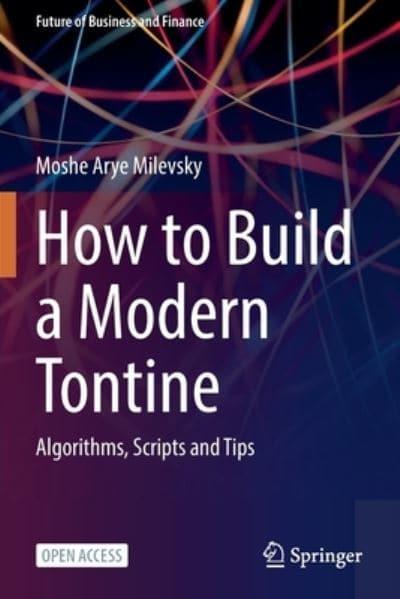
By Prof. Moshe A. Milevsky, Ph.D.
Special to the Financial Independence Hub
I have been asked about the difference between a tontine – be it modern or medieval – and a conventional life annuity, purchased from a regulated life insurance company. Both might appear to perform similar tasks at first glance, but the differences are subtle and important and get to the essence of the distinction between longevity insurance versus longevity (or survivorship) credits.
One aspect of the life annuity story is the financial benefit of risk pooling, and the other is the insurance benefit and comfort from having a guaranteed income that you can’t outlive. Allow me to elaborate with a statement that some readers might find shocking. If you are 75 years old with $100,000 in your RRIF and would like to guarantee a fixed annual income for the rest of your life, there is absolutely no need to purchase a life annuity from an insurance company to achieve that goal. There are other options.
This might sound like something odd for a long-term annuity advocate to say. But the fact is that a non-insurance financial advisor can design a lovely portfolio of zero-coupon strip bonds that will do the job. That collection of bonds will generate $4,000 per year for the rest of your life, even if you reach the grand old age of 115. Ok, financial advisors need to eat too, so they may not do it for $100,000, but I’m sure that a lump sum of $1,000,000 will pique their interest and in exchange you will get $40,000 per year.
Moreover, with these strips, if you don’t make it all the way to the astonishing age of 115, they will continue to send those $4,000 (or $40K) to your spouse, children or favourite charity until the date you would have reached 115, if you had been alive. This collection of strips would be completely liquid, tradeable and fully reversable, although subject to the vagaries of bond market rates. For this I have assumed a conservative, safe and constant 2.5% discount rate across the entire yield curve, which isn’t entirely unreasonable in today’s increasing environment.
Stated technically, the present value of the $4,000 annual payments, for the 40 years between your current age 75 and your maximum age 115, is exactly equal to $100,000 when discounted at 2.5%. Yes, those numbers and ages were deliberately selected so my numerical example rhymes with the infamous 4% rule of retirement planning but has absolutely nothing to do with it.
Now, I’m sure you must now be thinking (or even yelling) “Moshe, but what if you live beyond age 115, eh? You will run out of money!”
Touché. Let’s unpack that common knee-jerk reaction to non-insurance solutions for a moment. To start with, the probability of reaching age 115 is ridiculously and unquantifiably low. If you do happen to be the one in a 100 million (or perhaps billion) that reaches age 115, I suspect you will have other things on your murky mind. Personally and post-covid, there is a very long list of hazards that worries me more than hitting 115.
Nobody really “runs out of money” in this century
Second and more importantly, nobody really “runs out of money” in retirement in the 21st century. That is plain utter fear-mongering nonsense. With CPP, OAS/GIS, the elderly will continue to receive some income for as long as they live even if they have completely emptied every piggy bank on their personal balance sheet. In fact, with tax-based means-testing you might get more benefits if you actually do empty your bank accounts.
Ok, so back to my prior claim and the supporting numbers, if you want a guaranteed (liquid, reversable, bequeathable) income for the rest of your life, you can exchange your $100,000 for a bunch of strip bonds and voila, you have created a sort of pension plan. My point here is that the primary objective isn’t a guaranteed lifetime of income: which anyone can create with a simple discount brokerage account and a DIY instruction manual.
The goal is to get the HIGHEST possible income
and at the LOWEST possible cost.
Transferring the above-noted $100,000 into an insurance-company-sold income annuity would result in a guaranteed income of (approximately) $9,000 per year, which is $5,000 more per year, even if they cut-you-off (and forget to send you further payments) at age 115. That more-than-double number assumes the insurance company uses the exact same 2.5% interest rate to price their products, which they don’t. In fact, if I do the same simple math with a valuation rate of 3.5% instead of 2.5%, the $100,000 would generate $10,000 per year at age 75, with the income annuity. Back to my earlier example, the investment dealer or advisor would need to price strips at north of 8% to get me that sort of income. Not easy.
Now, the reason for this rather magical jump to $9,000 from a mere $4,000 is that via the income annuity I have pooled my resources with many other similar 75-year-olds, but have given up the assets in the event of early death in exchange for a subsidy to those living longer, etc. To repeat, the motivation and rationale for the life annuity is NOT to necessarily generate a guaranteed lifetime income to some ridiculous age. Again, I can do that with simple discount bonds. Nor should the rationale be driven by the fear of running out of money in retirement.
Rather, the legitimate concern retirees have is that their accustomed standard of living might be forcefully and involuntarily reduced if the markets don’t cooperate, and/or they live longer than anticipated. That can be mitigated by pooling resources and benefiting from mortality and longevity credits that accrue to those who are willing to share with their neighbours. Moreover, those credits will be more valuable in states-of-nature in which markets are performing poorly and the rest of my investments have taken a tumble. The implicit 8% return from a fixed-income product is the magic of longevity credits, a term I prefer over mortality credits.
Back to the Future of Tontines
This distinction between longevity credits versus longevity insurance opens the door for a universe of pooling investment products that don’t necessarily guarantee (or even offer) to pay income for the rest of your life, or guarantee anything for that matter. One can harvest mortality and longevity credits without requiring a rest-of-life horizon. For example, imagine a pooling arrangement that lasts for 20 years in which survivors inherit the investment assets of the deceased, thus acquiring mortality & longevity credits, but the entire fund is designed to be wound up when everyone reaches some predetermined age. That fund might not promise longevity insurance per se, but it would certainly include generous longevity credits. That is the modern tontine. Bringing longevity credits to the mutual fund universe.
Excerpted and edited from:
How To Build a Modern Tontine,
Copyright © 2022, By. Moshe A. Milevsky.

Moshe Arye Milevsky is a professor of finance at the Schulich School of Business at York University and a member of the Graduate Faculty in the Department of Mathematics & Statistics, in Toronto, where he has been teaching for over 25 years. He is the author of 17 books and more than 60 peer-reviewed academic papers. Named by Investment Advisor magazine as one of the 35 most influential people in the financial advisory business over the last 35 years, he received a lifetime achievement award from the Retirement Income Industry Association in 2008. His book: King William’s Tontine: Why the Retirement Annuity of the Future Should Resemble Its Past, was granted the Kulp-Wright (ARIA, 2017) award for the most important contribution to insurance. He was recently appointed Chief Retirement Architect for Guardian Capital’s new Retirement Solutions that incorporate his ideas on Tontine Thinking.


